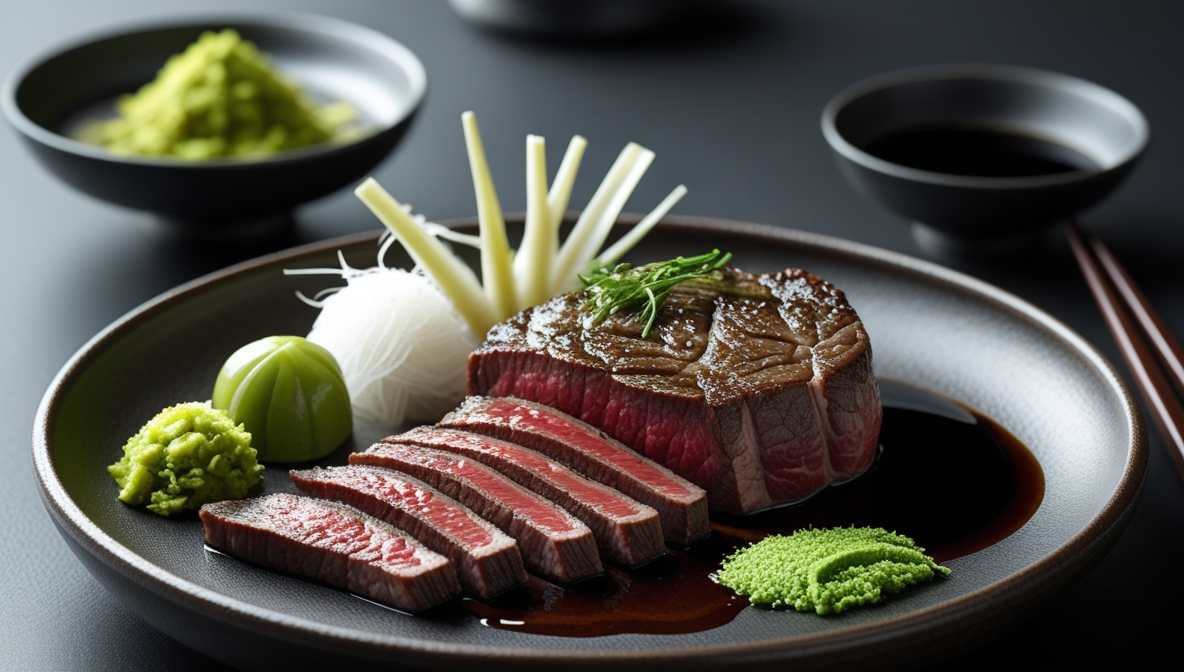Introduction
Wagyu Beef is more than just a delicious dish—it’s a cultural icon and one of the most famous foods in Japan. Known for its rich marbling, buttery texture, and deep umami flavor, Wagyu is celebrated as one of the world’s most luxurious meats. This exquisite beef reflects Japan’s deep culinary traditions and craftsmanship, making it a must-try for those exploring traditional Japanese food.


History & Cultural Significance
The term “Wagyu” combines “wa” (Japanese) and “gyu” (cow), and its origins trace back centuries. Initially used for agricultural work, these cattle were transformed through careful breeding after the Meiji era (1868) into the world-renowned meat producers they are today.
Today, Wagyu holds a revered place in Japanese culture, often served during festivals, holidays, and formal meals. It embodies the spirit of traditional Japan food, where quality, care, and aesthetics converge.
Ingredients & Regional Variations
Main Ingredient:
Premium Wagyu Beef (cuts like ribeye, tenderloin, sirloin, and chuck)
Typical Seasonings:
Sea salt
Optional: soy sauce, wasabi
Famous Regional Varieties:
Kobe Beef (Hyogo) – Arguably the most iconic Wagyu.
Matsusaka Beef (Mie) – Intensely marbled, rich in flavor.
Omi Beef (Shiga) – Japan’s oldest Wagyu brand.
Hida Beef (Gifu) – Velvety texture with bold flavor.
Modern Twists:
Wagyu burgers
Wagyu ramen
Wagyu tacos
Wagyu sushi
These adaptations ensure Wagyu stays relevant in both traditional and contemporary Japanese cuisine.
Cooking Process & Difficulty Level

Difficulty: Intermediate
Wagyu requires precision cooking to preserve its melt-in-your-mouth texture.
Best Wagyu Beef Recipe (Simple Pan-Seared Method):
Let the steak sit at room temperature for 30 minutes.
Lightly season with salt (and pepper, optionally).
Preheat a cast-iron skillet to medium-high.
Sear each side for 1–2 minutes.
Rest for 5 minutes before slicing.
Pro Tip: Medium-rare is ideal. Overcooking can reduce the signature marbling effect.
Where to Eat Wagyu Beef in Japan
If you’re wondering where to eat Wagyu Beef in Japan, here are some top spots:
Kobe Beef Kaiseki 511 (Tokyo) – An elegant experience with certified Kobe beef.
Matsusaka Gyugin Honten (Mie) – A haven for traditional Matsusaka beef.
Steak Aoyama (Kobe) – Michelin-recommended for authentic Kobe taste.
Yakiniku M Hozenji Yokocho (Osaka) – A hidden gem specializing in grilled Wagyu.
Each location offers a unique interpretation of Wagyu and highlights regional pride.
Drink Pairings & Side Dishes
Beverages:
Sake (Junmai, Daiginjo)
Aged Japanese whiskey
Full-bodied red wine like Cabernet Sauvignon
Perfect Side dishes:
Steamed rice
Miso soup
Pickled vegetables
Grilled veggies (e.g., mushrooms, asparagus)
These accompaniments enhance the flavor and complete the experience.
Fun Facts & Trivia
Contrary to popular belief, Wagyu cattle aren’t regularly massaged or fed beer—though these myths highlight the mystique surrounding them.
The fat in Wagyu melts at a lower temperature, giving it that soft, velvety texture.
Strict certification laws in Japan protect genuine Wagyu from imitation.
Health Benefits & Nutrition
Despite its decadent taste, Wagyu can be part of a balanced diet:
Rich in healthy monounsaturated fats
Contains omega-3 and omega-6 fatty acids
High in CLA, linked to heart health benefits
Diet Notes:
Naturally gluten-free
Keto-friendly due to high fat content
Best Wagyu Beef Recipe (For Home Cooks)
Ingredients:
200g Wagyu steak
Sea salt
Optional: wasabi, soy sauce, garlic chips
Steps:
Let steak reach room temp.
Heat pan (cast iron preferred) without oil.
Sear each side for 1–2 minutes.
Rest before slicing.
Serve with wasabi or soy dipping sauce.
Keep it Simple: The beef’s flavor speaks for itself—avoid heavy seasoning or sauces.
Global Influence & Fusion Cuisine
From Tokyo to New York, Wagyu has inspired chefs worldwide. It’s featured in:
Wagyu sliders in the U.S.
Wagyu ramen in Australia
Wagyu sushi in Singapore
Wagyu tacos in Mexico
Its versatility makes it a standout in both gourmet and street food scenes.
Wagyu vs. Other Premium Meats
Wagyu vs. USDA Prime (USA): Wagyu has more intricate marbling and a sweeter fat profile.
Wagyu vs. Argentinian Beef: Wagyu is richer and softer; Argentinian beef is leaner with a grilled edge.
Wagyu vs. Korean Hanwoo: Hanwoo is also premium but less marbled and less buttery than Wagyu.

